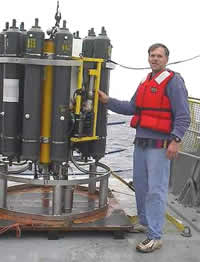| |

Dr. Joe Resing standing next to the scanner
used to perform continuous chemical analysis while in the water column.

Chemist Ron Greene is carefully
extracting a water sample to analyzed for helium.
|
|
Teacher Logbook - R/V Wecoma
Missy
Holzer 's Sealog:
CTD Cruise Day 10
Weather at 1630 hours PDT:
Overcast skies with winds of 12 knots from the
northwest, and visibility of 12 miles. Barometric pressure is 1026.9,
and
the temperature is 58 degrees Fahrenheit. Ocean swells are 5 feet out
of
the northwest, and the seas are 6 feet out of the northwest.
Hard to believe
that we've spent over a week sampling the water column above Axial volcano
and now it's time to move onto our next location on the Juan de Fuca Ridge.
This evening the NeMO CTD cruise will be steaming to the Cleft segment
of the ridge located about 60 miles south of our current location. The
Cleft segment of the Juan de Fuca Ridge is one the 3 most active segments
of the ridge along with the Axial and Endeavor segments, and has been
monitored by the Hydrothermal Plume Studies Group since 1986. Similar
sampling will take place at Cleft that has taken place at Axial: CTD casts
and tow-yo's.
During our
week at Axial, we completed 8 tow-yo's and 26 casts, along with recovering
5 and deploying 4 moorings. Within the casts and tow-yo's some interesting
chemistry techniques were in operation. A "scanner" as Dr. Joe
Resing calls it was used to do real-time chemical analysis while in the
water column. The apparatus appears to be pretty fragile with tubes, and
bags hanging loosely from its frame, but somehow the chemical reactions
take place every 5 seconds. Once the fish and the scanner have been recovered
Dr. Resing hooks up the scanner to a computer to gather the data about
the presence of iron and manganese in the vicinity of Axial volcano. Although
his predecessor developed the scanner, Dr. Resing has made some modifications
that a longer time series of data may be acquired.
Helium in
water? Isn't helium a gas? Well, helium like other gases can be trapped
in the ocean water (think of all the gas in a bottle of soda). Helium,
like other elements found on the periodic table, can be found in various
forms in nature. These other forms of the elements are called isotopes
and some of them are a bit more stable than other forms, or in the case
of helium, both are stable. In ocean water, a version of helium called
Helium-4 is about a million times more common than a version called Helium-3,
although both will rise in quantity after a hydrothermal activity. Chemist
Ron Greene has adopted an interesting method of extracting and analyzing
the quantity of helium present in the water column by using an air-tight
system involving cold welding of copper piping. He gathers samples from
approximately 5 Nisken bottles from each tow and cast. These prepared
samples are taken back to his lab in PMEL NOAA lab in Newport, OR where
he uses mass spectrometry to acquire the final ratios of Helium 3 to Helium
4 in each of the samples. What he has found from the data is that since
the 1998 eruption at Axial volcano, the helium signal has decreased due
to less helium being ejected in the plume sites. So long as the plumes
are somewhat active there will be a helium signal to monitor.
Work continues
as the NeMO CTD Cruise moves on to our next location. Come back on line
to check the status of our research at Cleft segment.
|

